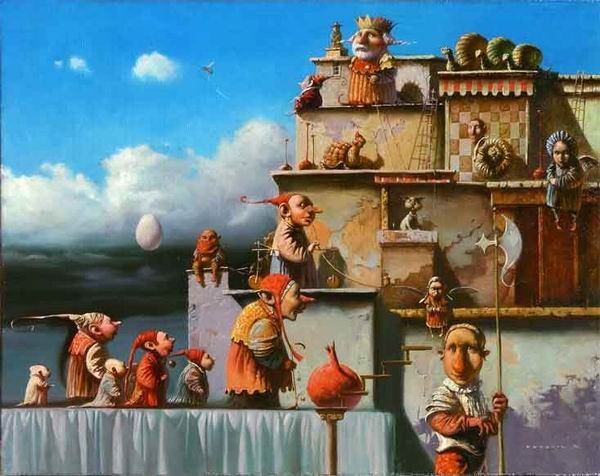
Chess is Not So About Moves
If not moves, then what?
Chess is more of construction business. We build up and improve position using components and building blocks. The word position itself means establishing a certain arrangement of parts to meet some needs.
When you play a game of chess it is like designing something or constructing a mechanism of some kind by which you win or lose. —Marcel Duchamp
To design is to decide upon the form, and functioning of a building, car, or software. And, if we are to believe Monsieur Duchamp, a chess game, too.
In the same way architecture is defined as the art and practice of designing and constructing buildings, chess is also some sort of design by which we create a carefully designed structure of chessmen and their relationships.
If this is so, then what are the basic building blocks of chess structure? What are the basic piece relationships?
 Gianluca de Grossi (Bologna), Control of the mind, 2016
Gianluca de Grossi (Bologna), Control of the mind, 2016
.
GM Averbakh defines four elementary relations between chess pieces, (1) Attack, (2), Restriction, (3) Protection, (4) Pin.
All these basic piece connections are not only geometrical. Very importantly, they are also functional!
Only functional connections between the system members give meaning and purpose to the system being observed.
For example, Black's Rook at h8, White's pawn at h2. Geometrically speaking, this is just a line segment, h8-h2. Functionally, Rh8 is <attacking> the opponent's pawn.
These elementary one-to-one relationships combine and make more complex structures, like multiple attack (e.g. double attack). There is one-to-many and many-to-one flavors of multiple attack. The former could be Knight's fork. The latter Queen and Bishop targeting f7 just before delivering Scholar's mate.
In general, at least two relations (like double attack, for instance) determine how structure is organized in any system. Relations determine the nature of the need and intents of how to meet the need. Relations determine how the need can be satisfied. In the end, relations, established between the members of a system, be it a corporation, or football team, or chess game, determine how we act.
All the intangible connections, all the invisible yet pregnant relationships between the component parts, present themselves in concert. It is up to us to perceive these intertwined threads and make meaning of them. Sometimes we do; sometimes we don’t. Regardless, independent of us, in the image they always simultaneously exist.— edge.org, credit unknown
In contrast to architecture of buildings, the chess structures are dynamic and are evolving in time. And that is where chess moves get in the picture. They are simply a means of how the board structure changes following the inherent logic and requirements of chess battle. If we learn how to properly "read" position, then ideas about right moves will come out quite naturally to us.
It is obvious that our obsession with moves should be replaced by the obsession with the Structure! Architecture. Design.
Chess is about Structure (and Ideas about Structure and how to improve, or strengthen it), not of moves.
.
.

